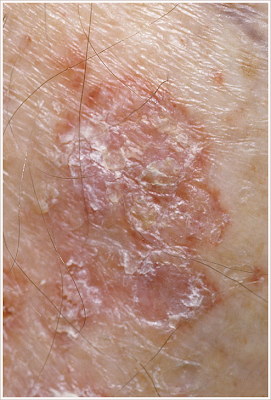Bowen's disease, also referred to as squamous cell carcinoma in situ, appears mainly on sun-exposed sites. Lesions are found most often on the lower limbs of women and on the scalp and ears of men. Typical lesions are slightly elevated, red, scaly plaques with surface fissures and foci of pigmentation. The borders are well defined, and lesions closely resemble psoriasis, chronic eczema, superficial basal cell carcinoma, seborrheic keratosis, and malignant melanoma. The plaque grows very slowly by lateral extension and may eventually, after several months or years, invade the dermis, producing induration and ulceration. When confined to the epidermis the atypical cells, in contrast to actinic keratosis, involve epidermal appendages, particularly the hair follicle. Atypical cells are also found at the periphery of lesions in clinically uninvolved skin. Atypical cells in the epidermal lining of the hair follicle, although still confined to the epidermis, are deeper and more difficult to reach by treatment modalities such as topical 5-FU or electrosurgery, which only permit access to superficial areas.
Immunohistochemistry may sometimes be valuable in differentiating Paget's disease, superficial spreading melanoma, and Bowen's disease.
The cause of Bowen's disease is unknown, but several patients with this disease were formerly treated with arsenic. There is no evidence that Bowen's disease is a skin marker for internal malignancy.
Treatment.
Small lesions may be successfully treated with electrodesiccation and curettage, cryosurgery, or excisional surgery. Larger lesions are treated with excisional surgery or 5-FU cream applied twice a day for 4 to 8 weeks. Treatment is discontinued when erosion and superficial necrosis occur. A large area surrounding the lesion should be treated in order to destroy the clinically inapparent disease. Some authors suggest plastic occlusion to enhance penetration to the hair follicle. Acetowhitening is a useful adjunct for surgical management. Acetic acid (vinegar) applied preoperatively more clearly defines clinical margins by disclosing subclinical extension of disease. Photodynamic therapy is an effective alternative for large lesions or those in anatomically difficult areas. Photofrin (a tumor-localizing photosensitive substance) is administered intravenously and activated by light from a laser 48 hours later. Cytotoxic substances are released that destroy the malignant tumor and preserve surrounding normal tissues. The most significant side effects are moderate pain and edema. Close follow-up of patients after treatment is required because recurrences are relatively common. Recurrence is related to follicular involvement and ill-defined lateral margins. If left untreated, development of invasive carcinoma is possible but uncommon.






Saturday, July 5, 2008
 What is Bowen's Disease
What is Bowen's Disease
Labels:
Bowen's disease
Subscribe to:
Post Comments (Atom)
0 comments:
Post a Comment